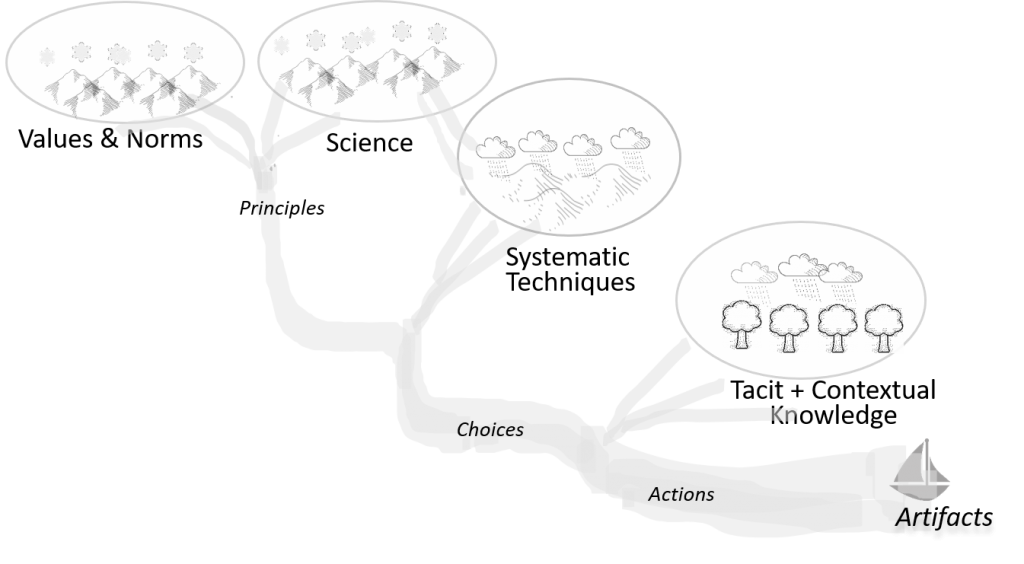Seminar on Productive Knowledge
(Manifesto-Like) Syllabus
My seminar examines the development of knowledge embodied in new artifacts (including physical objects, protocols, and organizations) intended to transform “existing conditions into preferred ones.”[i] We are particularly interested in knowledge “inclusively” produced by the many and for the many. Thus, we care more about how ready-to-wear footwear is designed, produced, and sold, than in customizing handcrafted boots for buyers who don’t think about the price. Likewise, general tools and techniques commonly used to produce a variety of artifacts are of greater interest than specialized tools. Thus, we are interested in how consumer goods, not just shoes, are designed, produced, and marketed.
By traditional intellectual standards, studying practical knowledge may seem undignified and uninspiring. The ancient Greeks venerated contemplation, music and the other arts, abstract truths, and mathematical reasoning. Merchants and craftsmen (including, presumably, builders of large hollow horses) occupied the bottom rung of Plato’s idealized society; their knowledge and toil was but a means towards the realization of the good life by a small enlightened class. Modern society has raised science into the pantheon of the wisdom we venerate. Engineers, physicians, lawyers, entrepreneurs, managers, and accountants earn high incomes; but, many dismiss their knowledge as a mere application of deeper scientific ideas or simply unfounded superstition. Similarly, in higher education: the first European universities started by offering practical medical and legal training and the University of Pennsylvania emerged from Benjamin Franklin’s 1749 proposal for an Academy to teach “those Things that are likely to be most useful.” The primary purpose of land-grant colleges created by the Morrill Act (signed into law by President Lincoln in 1862 was “to teach such branches of learning as are related to agriculture and the mechanic arts.” But now, some in the upper reaches of the Academy deride professional education as verging on the teaching of trades that must be kept in its subordinate place.
Yet, developing practical knowledge affirms an essence of our humanity. We are human because we create, not just because we think abstract thoughts. Beavers build dams, prairie dogs excavate underground towns, and crows craft toys. But, a relentless preoccupation with the development of artifacts that stimulate our senses and minds far beyond any natural physiological need sets our species apart. The artifacts embody knowledge created through the exercise of faculties that mark us as human: to imagine, to reason, to have faith and to control our anxieties, to communicate and collaborate with remote strangers, and to “truck, barter, and exchange” as Adam Smith put it. According to a recent book by evolutionary biologist, Joe Henrich, humans are not particularly physically impressive or even smart. Rather, our capacity for purposive cooperation has made humans a uniquely successful species.[i]
Synthesizing complex techniques and tools that we use to make the things we want is also uniquely human. At best, other species craft rudimentary implements by taking apart natural objects, such as twigs, whereas human civilization has been propelled by inventing sophisticated and roundabout ways to create what we desire. Our cave dwelling ancestors, unlike their simian progenitors, learned to kindle fires. The Neolithic or the First Agricultural Revolution started relieving us from the vagaries of nomadic hunting about 10,000 years ago through inventions such as irrigation, selective breeding of cereal grasses, and harvester’s sickles.
The Second Agricultural Revolution that started in Britain in the mid-17th century featured the development of crop rotation, breeding of livestock, land drainage and reclamation, and plows that could be easily pulled and controlled. The Industrial Revolution that started after about 1760, mechanized textile production through power looms and cotton gins, increased the efficiency of steam engines 5 to 10-fold, and slashed the cost of producing iron by using coke instead of charcoal in larger blast furnaces. And, whereas mobile phones and laptop computers may be the more celebrated manifestations of the Digital Revolution, specialized techniques and tools that many of us never see, such as computer-aided circuit design and numerically-controlled semiconductor fabrication, have made the visible consumer artifacts affordable and miraculously versatile.
The human instinct to jointly create practical knowledge and artifacts has enjoyed a momentous expansion over the last hundred years so (which we may roughly refer to as the “late-modern”). A highly inclusive, or to put it colloquially, massively multiplayer, game now provides unprecedented scope for individuals with diverse skills, capabilities and backgrounds to exercise their imagination and initiative. Before, the development of artifacts relied on exceptionally talented (but often not well-born) individuals. Similarly, where inventors once produced novelties principally for powerful or wealthy patrons, contemporary innovation relies on widespread consumption of affordable artifacts. And, combining inclusive consumption with inclusive development has made multiplayer innovations as consequential as the 19th century inventions, such as of telephones and automobiles, invented by and for the few.
Wide inclusivity has itself been supported by new techniques and tools. These include protocols that help organizations choose goals and objectives, produce plausible conjectures for attaining these goals, evaluate and refine the conjectures, codify and communicate selected ideas, motivate contributors and partition their tasks. The multiplayer game does not exclude unplanned discoveries and epiphanies. But, like farming after the agricultural revolutions, the inclusive development of new combinations (“ideas having sex” in Matt Ridley’s memorable phrase) relies more on careful, selective breeding than on accidental or anonymous encounters. Silicon Valley has not only produced path breaking technological advances; companies like Intel have also instituted pioneering goal setting systems to coordinate and control employees dispersed across diverse locations and functions.
Scientific discoveries have provided a crucial starting point for many technologies — the transistor principle for producing semiconductors or genetics for high yielding crops. And the increased output of scientific discoveries has provided more starting points. But, technology doesn’t just gush out of scientific geysers. Just as much of the water that a river carries into the ocean does not originate in headstreams, science does not provide all the important knowledge embodied in artifacts. The watersheds of practical knowledge (See Figure 1) include: values and norms, that along with science, provide the guiding principles; systematic techniques (as might be found in a text book in engineering or surgery) that harness the principles to produce choices; and, context specific tacit knowledge that turn choices into actions that culminate in new artifacts. To rephrase Schumpeter: apply as much electromagnetic theory as you please, you will never get a maglev train thereby. Similarly, the social sciences may offer general directions and signposts but cannot by themselves supply the organizational techniques that undergird inclusive innovation. Just applying cutting edge economics, sociology, or psychology could not have produced Intel’s goal setting system.

That scientific watersheds cannot by themselves provide all the knowledge embedded in artifacts is an intrinsic feature of science, not a defect. In his seminal The Scope and Method of Political Economy (1890) John Neville Keynes (father of John Maynard) argued against confusing the objective science of economics from value-laden ethical concerns about economic ends. Keynes also distinguished economic science from systematic techniques and precepts for attaining desired ends. Arguably, the distinctions help produce more and better science: if you want to find the glacial headstreams of a river stay away from the tributaries in the plains.
But the purposive development of artifacts requires choices of ends and the application of techniques: if you want to support farming and shipping downstream you need to know more than where rivers originate. You need to choose value-laden goals for downstream pollution and flooding, treat sewage, build locks and dams, and prevent soil erosion and deforestation in the lower watersheds. And, even the “upstream” principles of artifacts – such as the concept of ridesharing or airline loyalty programs — don’t always originate in a scientific watershed. (Figure 1 depicts some, not all, the sources of the knowledge artifacts embody.)
Moreover, effective ways of developing different kinds of practical knowledge are different. Methods designed for scientific discovery aren’t always best for choosing ends and developing and applying techniques. An inflexible adherence to methods demanded by specialized scientific communities can therefore hinder the development of artifacts.
Goals. We emphasize systematic techniques — the “mid-level” watershed in the diagram above; we will treat the normative and scientific watersheds “above” and the tacit knowledge watershed “below” mainly as complementary sources of knowledge. And, because even this mid-level watershed covers a forbiddingly vast territory, we will prioritize:
- Techniques that facilitate inclusive, multiplayer development over techniques that individuals may want to learn for their personal improvement such as time management. (We will however review techniques for individual use to illuminate the distinctive features of collectively used techniques.)
- Techniques used to perform tasks commonly encountered in many specialized domains (See Table 1) although the techniques themselves however may be domain specific.
- The main features and tradeoffs of alternative techniques rather than deep mastery in practices that experts have deemed as “best.”
Table 1: Common Tasks and Examples of Systematic Techniques reviewed in seminar
| Tasks commonly encountered | Examples of Techniques Reviewed |
| Goal and problem specification | Objective and Key Results; Journey Maps |
| Ordering and Screening Choices | Strategic Planning |
| Conjecture | Positive Deviance; Root Cause Analysis; |
| Codification | Checklists; Best Practice Programs; |
| Communication | Pyramid Principle; Tweeting |
| Testing and Evaluation | Randomized Control Trials; Rapid Prototyping; |
| Partitioning and Grouping Tasks | Organizational Templates; Project Management; |
| Aligning Incentives | Incentive Wages; Theory Y |
We aim to touch hearts as well as minds: to show that striving to satisfy others’ wants is a noble enterprise. Success may bring great material rewards, exhilaration and possibly a place in history, but innovators also face the possibility of ruinous loss, frustration and obscurity. To proceed on such a perilous path requires a love for adventure, and to continue when things go wrong demands courage. Thrift and bourgeois virtues of temperance and prudence celebrated by Max Weber and Deirdre McCloskey as the foundation of modern capitalism have their place — when joined to against-the-odds audacity.
Our mind-and-heart objectives limit the utility of studying well-codified “book” knowledge because many of the practices we are interested in have a fuzzy. Yet, whereas we can often best acquire individual skills (such as making a sales call, or performing an appendectomy) through hands-on practice, this is less feasible in tasks performed by large, geographically dispersed groups. Even projects undertaken by student teams over the course of an academic term cannot replicate the distinctive experience of protracted, widely inclusive development.
Therefore, we will rely on an indirect, case-method style approach. And because we are not interested mastering practices experts have designated as best, we will survey several popular techniques. Similarly, we will study the dynamics of multiplayer development by examining case histories of noteworthy artifacts (including new technologies, products, protocols, and organizations.) The case histories will also bring out the emotional challenges of doing something new to a greater degree than our survey of techniques.
